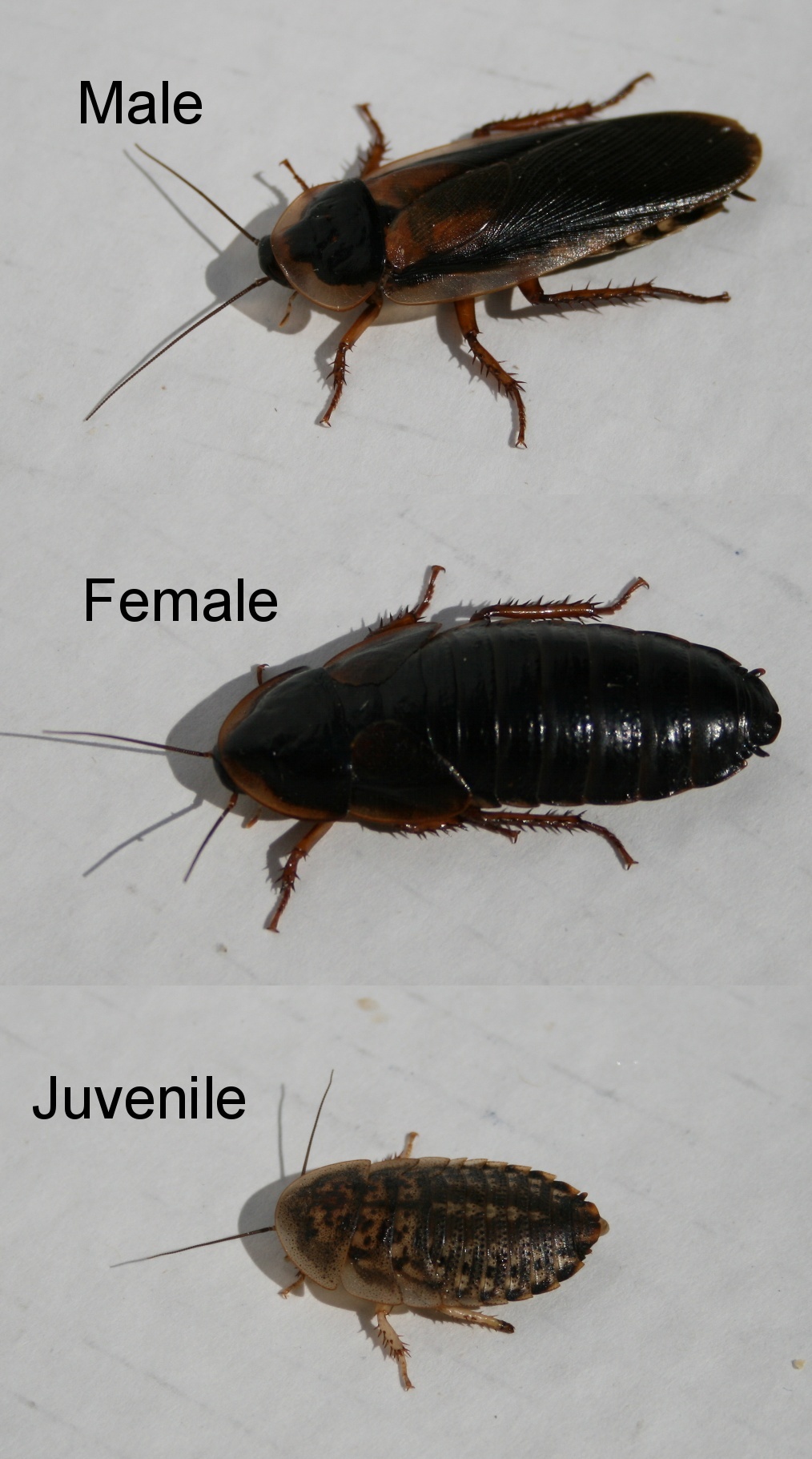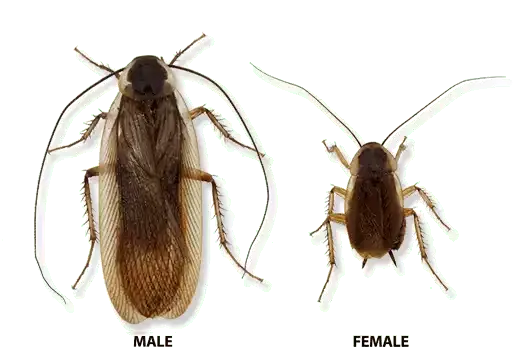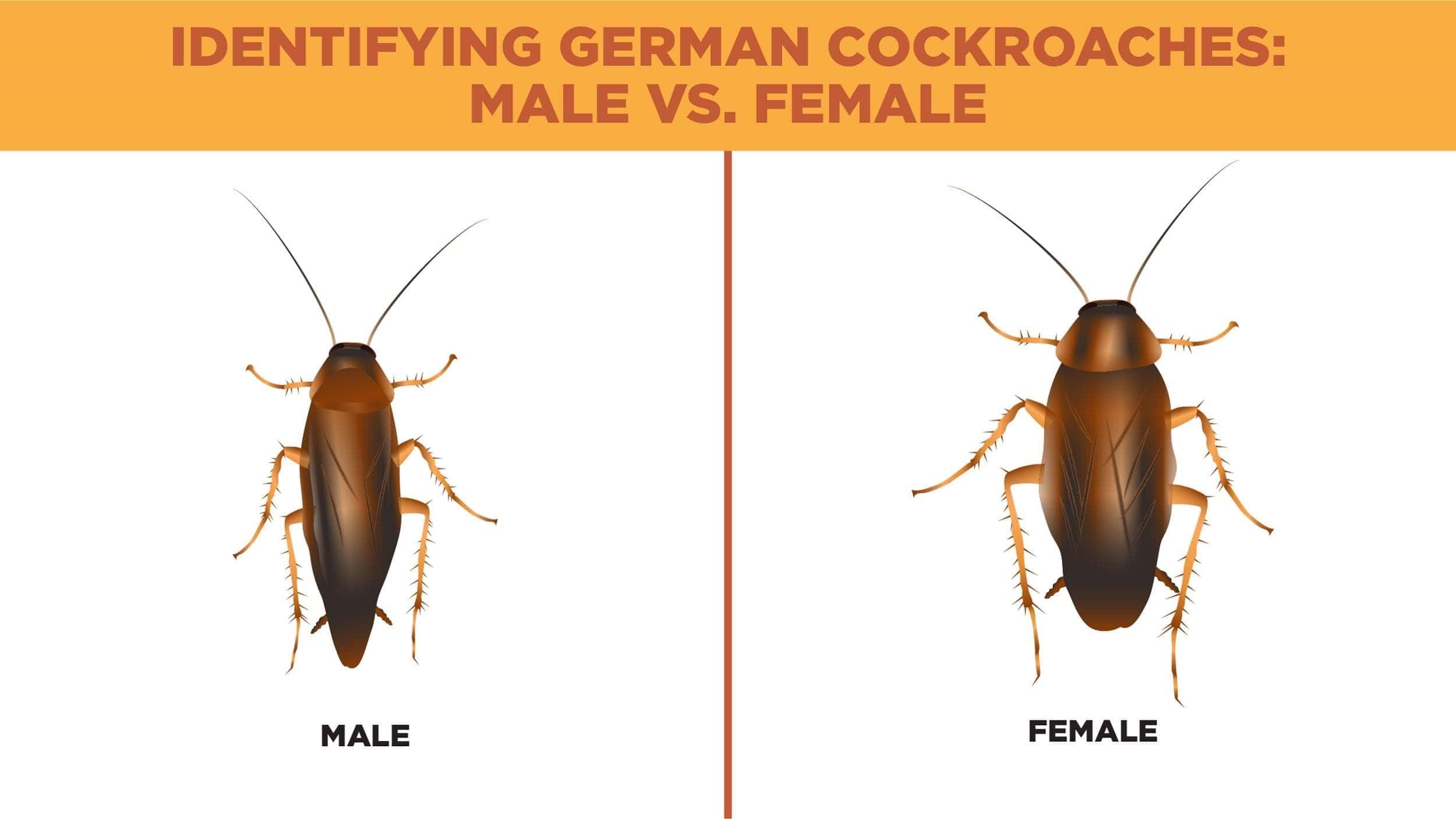A male cockroach typically exhibits a smaller, more slender frame than its female counterpart and usually bears longer wings. These wings often extend past the abdomen, unlike those of a female cockroach which are shorter or even absent in some species.
Understanding the appearance of a male cockroach is essential for both pest control and academic research. Cockroaches are among the most common household pests, and their identification can help in effective extermination. Entomologists recognize that male cockroaches may vary in size and color, but they share common features like the elongated wings and narrow bodies.
Homeowners interested in pest deterrence and enthusiasts with a curiosity for insect biology alike seek such information. Identifying a male cockroach can be the first step in recognizing an infestation, leading to timely and more focused pest management efforts.

Credit: en.m.wikipedia.org
Cockroach Distinguishing Features
Spotting a cockroach can be unsettling, but recognizing the specific traits of a male can help in understanding the pest problem. Not all cockroaches are the same. Size, shape, and even behavior vary between males and females. Learning these distinctions bears importance for identification and control.
Male cockroaches often sport longer wings that extend past their body. Unlike males, females usually have shorter wings that may not cover their abdomen fully.
Males also tend to have more slender bodies compared to the females’ rounder shapes. Some species show females without wings, a key difference from winged males.
The size of cockroaches generally varies between 1 to 1.6 inches in length, depending on the species. The common household types show clear size differences between genders.
Males can be easily identified by their streamlined shape, which is more tapered compared to females. The shape and size are essential clues for differentiation.
| Feature | Male | Female |
|---|---|---|
| Wings | Longer, extend beyond body | Shorter, may not cover abdomen |
| Body Shape | Slender, tapered | Rounder, broader |
| Size | Smaller in some species | Larger in some species |

Credit: www.rosepestsolutions.com
Winged Warriors: Male Cockroaches
Male cockroaches are not your average household pest. They boast a feature that often surprises many: wings. Unlike their female counterparts, male cockroaches come equipped with wings, earning them the catchy moniker ‘Winged Warriors’. But what do these wings really look like, and how are they used? Let’s take a closer look at these fascinating features.
Presence Of Wings
The presence of wings can be a dead giveaway to identify a male cockroach. Most male cockroaches have wings, but not all species use them for flying. In most common species, such as the American cockroach, only the males display a set of fully developed wings which cover the full length of their abdomen.
Wing Size And Movement
The wing size in male cockroaches varies but extends beyond the abdomen. This is unlike the females whose wings, if present, are typically shorter and do not cover the entire abdomen. Male roaches may flex their wings to glide or flutter when disturbed, making them more evasive than their female counterparts. However, don’t expect an aerial show; most cockroaches are not adept fliers.
Color Patterns And Markings
Distinguishing a male cockroach begins with observing its color patterns and markings. While many might overlook these details, these characteristics are crucial for identification. Let’s explore the common coloration and unique markings of male cockroaches.
Common ColorationCommon Coloration
Male cockroaches often share a set of common hues. These color patterns provide essential camouflage within their environment.
- Brown: Most male cockroaches are various shades of brown.
- Tan: Some exhibit a lighter tan or sand-colored tone.
- Dark brown: Other males may be darker, leaning towards a chocolate color.
Unique Markings
Individual species of male cockroaches have unique markings that distinguish them from others.
| Species | Distinctive Marking |
|---|---|
| American Cockroach | Yellow figure-eight pattern on the back of the head |
| German Cockroach | Two dark, parallel stripes running from the head to the wings |
| Oriental Cockroach | Glossy body without prominent markings |
Body Structure
Understanding the body structure of male cockroaches can help easily differentiate them from females. Key physical traits are evident when looking at the insect’s size, shape, and wing development. In this section, we’ll take a closer look at the distinctive aspects of a male cockroach’s physique.
Comparing Body Proportions
Male cockroaches have notable differences in body proportions compared to their female counterparts. The most striking feature is their overall smaller and more streamlined build. Let’s break down the specifics:
- Size: Males tend to be less robust and lighter.
- Wings: Their wings are usually longer and more pronounced.
- Antennae: Look for the long and thin antennae, which are indicative of a male.
Tapered Lower Bodies In Males
The abdomen of a male cockroach presents a more tapered appearance towards the end. This tapering is less prominent in females. A visual comparison reveals:
- The male’s abdomen ends in a pointier shape, while females have a rounder back end.
- In certain species, the presence of sexual organs is visible on the underside of males.
These distinctive shapes play a crucial role in mating, as they ensure that males can effectively locate and mate with females.
Reproductive Differences
Understanding the reproductive differences between male and female cockroaches is key in identifying them. Males often display distinct physical traits that hint at their role in reproduction. Let’s delve into the specifics of male cockroach reproduction.
Oothecae And Egg Cases
Female cockroaches produce oothecae, or egg cases, after mating. These cases are easily distinguishable:
- Shape: Typically oval and elongated
- Color: Dark brown or black
- Size: Contains multiple eggs inside
Male cockroaches do not carry or produce these egg cases. Spotting an ootheca indicates the present or past activity of female cockroaches.
Fertility Clues
Several features can give away a male cockroach’s fertility status:
- Body Shape: Males are sleeker with more streamlined bodies.
- Wings: They often have longer wings relative to females.
- Behavior: Males can be more active, especially during mating season.
These clues can help in isolating and identifying male cockroaches from their female counterparts.
Credit: www.quora.com
Species-specific Traits
Understanding male cockroaches requires looking at their unique characteristics. These vary across species. Distinct features help identify male cockroaches from their female counterparts. Let’s explore the traits of two common species, each with their own telltale signs.
American Cockroach Differences
Male American cockroaches display several distinct traits that set them apart:
- Body Size: Males tend to be larger, reaching up to 53 mm.
- Wing Length: Their wings extend past the abdomen.
- Speed: They are known for their quick movement.
German Cockroach Features
Male German cockroaches can be recognized by these features:
| Feature | Description |
|---|---|
| Body Shape | Longer and thinner than females. |
| Color | Light brown with two dark stripes. |
| Wings | Wings cover the entire length of the body. |
False Alarms
Identifying a male cockroach often leads to mistakes. People might think they’ve spotted one, only to find a different insect. To clear up this confusion, let’s delve into common cases of mistaken insect identities.
Mistaken Insect Identities
Different bugs resemble cockroaches, but they’re not the same. Mistaking these insects for cockroaches is common:
- Beetles: Vary in size and shape but lack the cockroach’s distinct flat body.
- Crickets: Also brown but have long antennae and jump.
- Water bugs: Similar in color but usually found near water sources.
Eliminating Confusion
To avoid mistaking other insects for male cockroaches, pay attention to these details:
| Feature | Male Cockroach | Other Insects |
|---|---|---|
| Size | Smaller than females | Varies greatly |
| Wings | Long, extending beyond body | Short or absent |
| Body Shape | Long and slender | Round or oval |
Examine insects closely and compare them with credible images to ensure accurate identification.
Observation And Identification
Identifying a male cockroach can be intriguing and informative. Knowing their appearance is key to control and prevention.
Finding And Identifying Cockroaches
Male cockroaches differ from females in size and wing length. To spot a male, look for a slender body and longer wings that extend beyond the abdomen.
- Size: Males are usually smaller.
- Wings: They possess longer wings compared to females.
- Shape: Their bodies are more streamlined.
Common Misconceptions
Many bugs resemble cockroaches, leading to confusion. For example, beetles often get mistaken for roach nymphs.
| Insect | Resemblance to Cockroaches |
|---|---|
| Red Flour Beetle | Dark color, oval shape |
| Confused Flour Beetle | Similar size and wings |
Frequently Asked Questions
How To Tell If A Cockroach Is Male Or Female?
To distinguish cockroach gender, examine body size and wing length: males are usually smaller and have longer wings than females.
What Do Female Cockroaches Look Like?
Female cockroaches generally have broader, more rounded bodies than males and exhibit shorter wings that don’t extend past their abdomen.
What Bug Can Be Mistaken For A Roach?
Beetles, especially the June beetle and the ground beetle, are often mistaken for cockroaches due to their size and shape.
Conclusion
Identifying male cockroaches is simpler with a keen eye for detail, recognizing their slender build and longer wings. This knowledge is not only intriguing, but also critical for effective pest control. So, next time you spot a roach, observe closely—you might just tell if it’s a male.
Remember, understanding your adversary is the first step in effective management. Stay informed and proactive in your pest control endeavors!
Related posts:

I’m MD Tanvir, and I bring years of expertise gained from working closely with pest control companies to the forefront. My journey in the industry has inspired me to launch Bug Battler, a platform aimed at equipping people with the know-how to combat pests autonomously. Through Bug Battler, I aim to empower individuals with practical insights to tackle pest infestations effectively.

